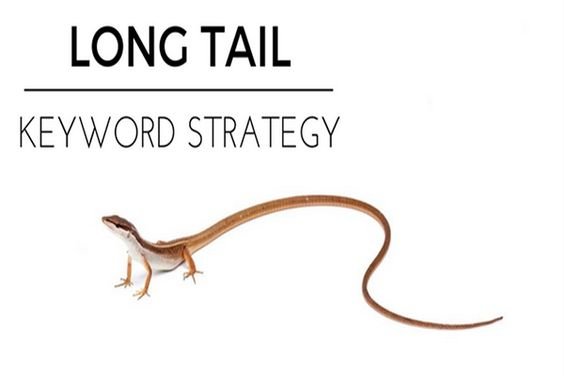
Choosing the right keywords is crucial for SEO success. Long-tail keywords are more specific and face less competition, whereas short-tail keywords are broader and generally more competitive. Navigating the complexities of keyword selection can be akin to maneuvering through a maze, yet mastering this aspect is essential for securing a top spot on Google’s first page.
The choice between long tail vs short tail keywords plays a significant role in shaping your SEO strategy. In this post, we’ll explore the differences between these two types of keywords, helping you craft a well-rounded strategy that incorporates both. By the end of this read, you’ll gain a deeper understanding of keyword competition, search volume, and user intent.

Image: Pinterest
Long-tail keywords consist of three or more words that people use to search for specific information or items online. For example, instead of merely searching for “boots,” someone might look for “men’s leather boots size 7.” Utilizing more words in the search query increases the likelihood of finding exactly what one is looking for, thanks to the greater specificity.
SEO service providers assess long tail vs short tail keywords to craft a targeted strategy that boosts their clients’ online visibility, ensuring a mix that caters to immediate traffic gains and niche market penetration. They evaluate the client’s industry, competition, and audience behavior to determine the optimal balance between long tail keywords for specific queries and short tail keywords for higher search volumes.
To grasp the concept more intuitively, consider the following real-world examples:
These examples illustrate how long-tail keywords can refine search outcomes. As such, they are particularly useful for businesses aiming to target specific demographics and advertise to niche markets.

Image: Pinterest
Short-tail keywords consist of one or two words and are also referred to as head or primary keywords. These terms are usually quite general, garnering a high volume of searches but also facing intense competition.
For instance, if you enter “coffee” into Google, you’re using a short-tail keyword. While this term is popular and might be searched by thousands or even millions of people, its vagueness means the results could range from local coffee shops to articles discussing the health benefits or historical origins of coffee.
Ranking highly for such popular keywords can be a challenge, as large corporations with extensive resources often dominate these spaces. However, if you manage to successfully rank for these general, high-traffic keywords, it could significantly boost the visibility and traffic to your website.
To clarify, let’s look at some typical short-tail keywords that people frequently search for:
Such generic terms yield a variety of results due to their lack of specificity. For example, a search for “shoes” will produce a multitude of options from various retailers, along with articles and fashion blogs discussing the latest footwear trends.
Short-tail keywords are more generalized and thus have a higher search volume, but they also come with increased competition. Long-tail keywords, on the other hand, are specific, garnering lower search volumes but facing less competition. Striking the right balance between the two is crucial during keyword research.
The efficacy of your SEO strategy largely hinges on your keyword selection, whether you opt for longer or shorter phrases. Both types come with their own sets of advantages and challenges, particularly concerning competition and search volume.
“Search volume” refers to the number of times a keyword is queried within a specific time frame, usually monthly. “Competition” denotes the number of websites vying for a ranking using the same keyword.
Short-tail keywords are generally associated with high search volumes. Terms like “pasta” or “shoes” are often queried due to their broad applicability. However, this widespread popularity is a double-edged sword: while they attract more searches, they also face stiffer competition.
Conversely, long-tail keywords may initially attract fewer visitors because of their specificity (e.g., “gluten-free vegan pasta in London”). However, lower search volume shouldn’t deter you; it often indicates reduced competition, making it easier to rank higher and target a more niche audience.
Shorter, more general keywords often face greater competition, as numerous websites vie for ranking with these common terms. However, don’t overlook the niche markets carved out by specific, long-tail keywords that cater to unique user needs. Employing these detailed terms in your content can help your business rank higher in search results, even if the search volume for these terms is relatively low.
Choosing between a wide array of keywords and highly competitive ones isn’t a straightforward decision; it depends on your specific situation and strategy. The key is to find a balanced approach that maximizes visibility without draining your resources.
User intent refers to what a person aims to find or achieve when they use a search engine. Comprehending this concept can significantly influence how you perceive the value of long-tail versus short-tail keywords. Let’s delve into how each type of keyword correlates with user intent in SEO.
Also read: FROM ONE SEO AGENCY TO ANOTHER: TOP 11 SEO PROJECT MANAGEMENT INSIGHTS
Short-tail keywords, often composed of one or two words like “chocolate cake,” are generally vague and attract a high volume of traffic. However, they offer little insight into what exactly users are looking for.
For instance, when someone searches for “chocolate cake,” it’s unclear whether they’re seeking recipes or looking to buy from a nearby bakery. Such ambiguity makes it challenging to create content that precisely fulfills a specific need.
Contrastingly, long-tail keywords provide a more nuanced picture. These are longer, specific phrases that target a narrower audience. While they may generate less traffic than their short-tail counterparts, their specificity offers distinct advantages.
Consider the keyword “best sugar-free chocolate cake recipe.” Although this term may not be searched as frequently as “chocolate cake,” it provides a clearer indication of what the user is seeking. They’re not merely looking for a recipe; they’re in search of the ‘best’ one and specifically want it to be sugar-free.
Once you grasp how long-tail keywords align with user intent, you can tailor content to capture the audience’s attention and meet their specific needs. Imagine the delight of a user searching for sugar-free chocolate cake when they come across an article titled, “The Ultimate Sugar-Free Chocolate Cake Recipe You’ll Ever Try.”
The choice between long-tail and short-tail keywords can be distilled to the following user intent considerations:
Striking a good balance between these two types of keywords can effectively attract and engage your audience.
While it may be tempting to aim for broad reach and high traffic, it’s essential to consider conversion rates, where long-tail keywords often outperform their short-tail counterparts.
Long-tail keywords are more focused and detailed than short-tail ones, offering a unique advantage: precise targeting. Users employing such specific search terms typically have a clear intention, making them more likely to take action, such as making a purchase.
For example, consider someone on the verge of making an online purchase. They’re unlikely to simply search for “shoes.” More likely, they’ll use detailed terms like “brown running shoes size 8,” indicating a strong intent to buy.
The specificity of short-tail and long-tail keywords plays a crucial role in their effectiveness. While short-tail keywords attract a broad audience, they may not necessarily lead to conversions. In contrast, the detailed nature of long-tail keywords often prompts users to take action.
For instance, someone searching for a “blue PVC vase” (a specific, long-tail keyword) is more likely to make a purchase than someone who merely searches for “vase” (a general, short-tail keyword).
Also read: 20 BEST SMALL SEO TOOLS TO IMPROVE YOUR RANKINGS
Locating the right keywords may seem challenging, but various tools and strategies can simplify the task. One such resource is AnswerThePublic, a free service that generates questions related to your primary keyword. These questions often serve as excellent examples of long-tail keywords.
To stay current on what people are searching for, you can use features like Google Auto Suggest and “People Also Asked.” These options reveal the phrases people are commonly using in their searches, both short and long. Additionally, competitor analysis can provide invaluable insights.
Tools such as SEMrush and Ahrefs reveal the keywords your industry competitors are using to gain high search rankings. This information can guide your own keyword strategy for both short-tail and long-tail terms. However, simply identifying the right keywords is not enough. It’s crucial to understand the context in which they’re most effective, especially in terms of user intent.
Effective keyword research is not just a technical exercise but a blend of creativity and analytical thought. It plays a crucial role in directing the right audience to your website by enabling you to select the most appropriate words and phrases. While the process may be time-consuming and require patience, the resulting boost in web traffic and conversions makes it a worthwhile endeavor.
Balancing short-tail and long-tail keywords in your SEO strategy is crucial for attracting a well-rounded audience. Think of it as creating a harmonious ecosystem where both types of keywords complement each other. Short-tail keywords generate high search volume but face intense competition, while long-tail keywords are more likely to result in conversions. For instance:
This tiered approach not only increases brand awareness but also provides valuable information to those who are already knowledgeable about the subject. When attempting to integrate both types of keywords into your strategy, consider the following tips:
Know Your Target Audience: Understand user intent to tailor your keyword choices effectively.
Deploy Them Strategically: Use short-tail keywords for broad-reaching topics and elaborate with long-tail keywords for more detailed discussions.
Keep It Current: The digital landscape is ever-changing, so it’s vital to regularly update your keyword strategy to stay relevant.
Mastering the nuances of both short-tail and long-tail keywords may be challenging initially, but the effort will pay off in the form of a more effective SEO strategy. As with any solid plan, achieving the right mix involves experimentation and ongoing adjustments based on audience preferences and behaviors.
Final Thoughts
When it comes to SEO, both long-tail and short-tail keywords offer distinct advantages. Short-tail keywords can significantly boost your website’s visibility due to their high search volume. However, they also come with increased competition and may lack clarity in conveying user intent.
In contrast, long-tail keywords, although more specific, pinpoint exactly what the searcher is looking for and are more likely to result in conversions. The key is to strategically blend these two types of keywords to meet your specific goals. For optimal search engine visibility, a mixed approach that incorporates various tactics and emphasizes effective keyword utilization is essential.
Yes, it’s challenging but achievable to rank well for short-tail keywords. To improve your odds, focus on producing high-quality, relevant content, securing credible backlinks, and optimizing your web pages. A balanced use of both short-tail and long-tail keywords can diversify your audience and keep you competitive.
Short-tail keywords can attract a large audience but are often highly competitive. Long-tail keywords face less competition but also draw fewer searches. A balanced approach is ideal: use short-tail keywords to garner broad visibility and long-tail keywords to target a more niche audience with specific interests.
You can employ specialized keyword research tools like Google Keyword Planner to find valuable long-tail keywords. Another strategy is to examine related searches and query suggestions on search engines. Opt for phrases that align with your content and address the user’s specific needs.
The effectiveness of long-tail versus short-tail keywords depends on your content, target audience, and overall objectives. Long-tail keywords are crucial for addressing specific user needs and attracting a niche audience. Short-tail keywords are better suited for broader topics that aim to reach a larger audience. A well-rounded SEO strategy should incorporate both for the most comprehensive results.
Subscribe to learn how to grow and scale your business through white labelling, starting with this free guide. Unsubscribe with one click at any time.
We hate SPAM and promise to keep your email address safe. Here’s our privacy policy.